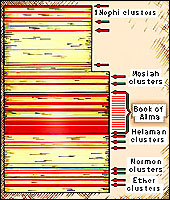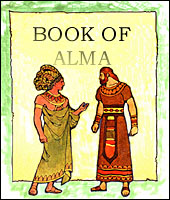

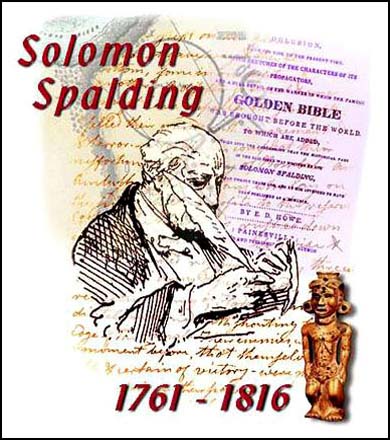
AN INTRODUCTION
to the Solomon Spalding Pages printed
in the 1830 Palmyra Book of Mormon
links | introduction | charts and illustrations | storyline examples
1830 texts: Book of Mosiah | Book of Alma 1 | Book of Alma 2 | Book of Ether
authorship charts: Mosiah Chart | Alma Chart 1 | Alma Chart 2 | Ether Chart
I first encountered the late Vernal Holley in a Salt Lake City used book shop during the winter of 1975-76. This was years before Vernal published his "Book of Mormon Authorship" booklet, and he was then a total stranger to me. The tall, slender and rather shy man introduced himself to me as a fellow Latter Day Saint (he then being LDS and I being Reorganized LDS) and I found that he lived near my former home in the Ogden area. One thing led to another and when our conversation turned to issues surrounding the Book of Mormon, Vernal grabbed a copy of the 1910 LDS edition of Solomon Spalding's "Manuscript Story" off the sales shelf and began showing me word-strings of three to five words in length, that he said were also to be found in the the text of the Book of Mormon. At the same time, Vernal recited a mental list he had made of the many plot elements which are common to that old Spalding tale and the Mormons' first book of latter day scripture. "Well, Dale, what do you think?" was his expectant query. I was not familiar with the subject matter, except from some half-remembered family traditions, and I replied that the phraseology and thematic parallels he had pointed out to me seemed to be the sort of stuff that any two purported histories of the ancient Americans might share -- similarities due to the subject matter and the nineteenth century language that they had in common. Vernal was disappointed that I had so easily dismissed his textual examples as odd coincidences, but he gave me his phone number and we kept in contact after that. My curiosity was also sparked enough that I decided to buy the 1910 Spalding book, and for months thereafter I would occasionally browse through the text, penciling in marginal notes and references to Book of Mormon passages as I absorbed and pondered the odd story. This chance encounter with Vernal Holley -- and through him, with the Spalding authorship claims -- led to my eventually making the theory for a nineteenth century Book of Mormon the topic of my graduate studies. Near the end of that work I prepared a preliminary report entitled "A New Basis for The Spalding Theory," much of which was based upon Vernal Holley's ideas about the possible relationship betwwen Solomon Spalding's known writing and the text of the Book of Mormon. At the same time I was preparing my textual similarities for this 1980 paper, Vernal completed an exhaustive comparison of the 1910 Spalding edition with the LDS Book of Mormon. The two of us independently came to similar, startling realizations at about the same time: that the last one-third of the Book of Mormon's "Book of Alma" comprised a text more closely resembling the theme and language of Spalding's writings than any other part of the "Nephite Record." While other sections of the Mormon book contain clusters of "Spaldingish" story-telling, here and there, the block of text running from the 1830 edition's Alma XX to Helaman II (Pages 340-413) is singularly unique in its length and its multiplicity of Spalding literary parallels. Vernal Holley was the first person to assign a name to this section of the Book of Mormon (Modern LDS edition: Alma 43:1-63:17 and Helaman 1:1-3:12) -- he referred to it as the "Book of Solomon." 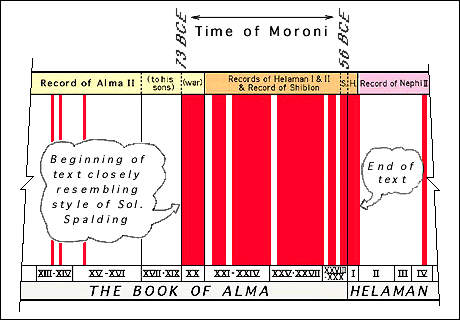
"Figure II (detail)" from page 9 of "A New Basis for the Spalding Theory" A Promise Belatedly Kept A few months before his passing away in 1992, Vernal Holley asked me if I would carry on his research by making a expanded and annotated e-text of Book of Mormon Authorship available on the web. Although I have made some initial efforts in this direction, I felt constrained to hold back Vernal's "Book of Solomon" ideas, for a couple of different reasons. First of all, I had only his rough notes, the contents of which are superficially similar to the unsubstantiated claims made in 1977 for actual pages of Spalding's handwriting having been retained in the Original Manuscript for the Book of Mormon. While Mr. Holley never supported those wild assertions of the late 1970s, his own theory of how the "Book of Solomon" was preserved within the published Book of Mormon sounded so much like the widely-refuted handwriting assertions, that it seem inevitable that the two theories would be conflated and confused with each other. Just as one of the handwriting experts publicized in the 1970s news articles died without leaving any final report, Vernal had also passed on without having compiled anything like a finished draft for his own "Book of Solomon" ideas. Prudence seemed to dictate my holding back Mr. Holley's opinions until they could be better substantiated than were those discredited handwriting claims. Another constraint I felt (and rather heavily at some times, I must admit) came in the form of peer pressure from my fellow RLDS and Community of Christ friends and scholars. For many years I hesitated in accepting the basic premise of the Spalding-Rigdon authorship explanation -- and for months after the fact, I still hesitated in making a public announcement of my conclusions in that regard. Only since my departure from the ranks of Community of Christ have I felt relieved from the restraints I have here alluded to. But with that last barrier surmounted, I can now begin to lay out before a public audience the conclusions Vernal and I shared concerning what he called the "Book of Solomon." |
If I look out upon my backyard garden and see that several clumps of weeds have grown up among my flowerbeds, how might I communicate my unexpected discovery? My next-door neighbor, having glanced at the same sight, might say to me: "I see only flowers in view and no weeds at all." I could spend a good deal of time trying to tell him why I think that certain flowering plants are "weeds," and what exactly I mean by a "clump," and why the my discovery of those weeds is a matter of importance to me. Or -- I could take a snapshot of my garden, circle the images of the weeds in bright red ink, and draw lines from the encircled images over to an attached list of names of common weeds. My neighbor might still disagree with my calling those indicated plants "weeds," but at least he would know where they were located in among my flowerbeds. It is for this very reason that over the years I have created a number of charts and graphs for the Book of Mormon text and for the Oberlin Splding manuscript text. I've already presented a detail from one of those sets of charts in the first section of my Introduction, to quickly and clearly show what I consider to be the physical limits of what Vernal Holley first called the "Book of Solomon." My purpose here is not to try and prove a Solomon Spalding authorship with any number of colorful graphics: rather, I just wish to thus point my finger and say to my scholarly neighbors, "Don't you see the weeds?" In his oral response to my 1982 Mormon History Association presentation, "The Secular and the Sacred," Dr. Lester E. Bush, Jr. opined that such Book of Mormon charts had no particular significance in developing arguments pro or con in regard to the Spalding-Rigdon authorship theory for the Book of Mormon. Dr. Bush did not challenge the accuracy of the charts presented in my earlier paper, "A New Basis for The Spalding Theory," as accurately depicting the "Nephite Record's" reproduction of biblical Old Testament and New Testament quotations and phraseology in that 1982 paper, but he was singularly unimpressed with my attempt to overlay those two depictions with a third chart, indicating "Spaldingish" passages in the same Mormon book. Exactly why Bush could not accept my application of the same illustrative methods for Spalding as he could accept for the biblical language continues to escape my understanding, but his main criticism appears to have been that my charting of the Spaldingish language in the book was neither quantatively precise nor linguistically unique. In other words, I had failed to convince him that my marking of the Spaldingish Book of Mormon sections made use of an exhaustive and rigorous statistical methodology whereby all the words and phrases in common with Spalding's writings were assigned a proper distribution weight, deviation from the mean numerical ranking, etc. And, on the other hand, had I carried out such an exhaustive and precise selection of the words and phrases to be depicted in my color-coded, generalized chart, Bush would have still argued that the charted results would be meaningless, until the same procedure had been carried out upon numerous other pre-1830 fictional writings in English, and those results charted and referred to in order to provide a proper context for my visual presentations. More recently a noted author of several books and articles dealing with Mormon origins, Dan Vogel, has complained in postings at the Mormon Discussions Board, that the creation of such illustrative graphics is "perhaps committing the fallacy of 'impossible precision.'" Dan thus provides a criticism exactly opposite to Dr. Bush's complaint about there being a seeming lack of precision in these "fancy charts" (as Dan Vogel calls them). His explanation is that the graphics "are only as good as the research that they illustrate. But that's where I have the most difficulty. We need to examine your use of parallel evidence to see if you have established Spalding as the source for the phraseology. Otherwise, your charts simply beg the question if we take them as proof of something." At least the latter critic has mentioned the possibility of examining the garden to see if there are truly any weeds there. The former Mormon scriptures expert (Dr. Bush) dismissed the entire subject as being unworthy of any further investigation. So, Where's the Proof? Both Bush and Vogel have made the mistake of thinking that my illustrations are an attempt at providing proof of the Spalding-Rigdon (or Spalding-Rigdon-Smith) Book of Mormon authorship theory. I have no intention of using them as a demonstration of any sort of "proof." They are illustrations of a "new basis" for a theory, and as such they are meant to call the reader's attention to certain ideas and possibilities. Still, in my publicizing Vernal Holley's old assertion of there being a "Book of Solomon" embedded within the books of Alma and Helaman, I am voicing a personal opinion that further textual investigation is not only warranted -- it will eventually become a key point in our deciding in favor or in disfavor of these authorship claims. Since some critics have assumed that the production of these graphs is little more than subjective whimsy, I'll take a little space here to give a demonstration of the quantitative methodology I've applied to their production. I'll begin by referring back to an enlarged and enhanced version of the same chart I spoke of earlier: 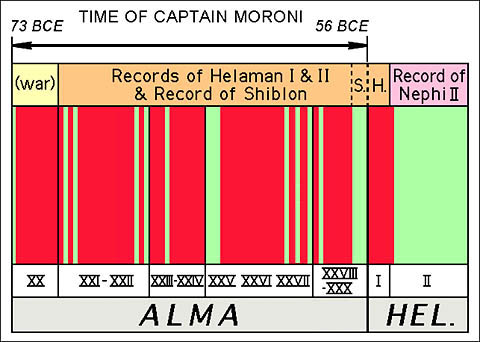
Here the visual message presented is: "In the 1830 Book of Mormon, chapters XX-XXX of Alma tell the story of Captain Moroni -- this is the part of the book which most resembles the known writings of Solomon Spalding." Now that visual message may be true or false -- easily accepted or endlessly refuted -- but that is all that the chart is really saying. It serves as an invitation for the reader to look more closely at that particular section of the Nephite Record, to see if any of it truly does read like the fictional narratives of Solomon Spalding. Once a reader has decided to consider such an assertion, I'd advise him or her to take a closer look at the chart, to see what secondary information it might communicate. The observer will see that the "Spaldingish" text is shown in red and that some sections not so Spaldingish is shown in light green. In several instances these green sections are located at or near the book's internal chapter breaks. In addition to this, there is an adjoining red section comprising a little more than the first chapter of Helaman. Thus, I've visually depicted a secondary discovery -- that the text less resembling Spalding's language generally occurs at or near narrative transitions from one chapter (or topic) to another. Such a distribution of "alien" textual segments may indicate the handiwork of an editor, who has changed or expanded the language at these regular breaks in the continuing story. One Picture Explains Another The skeptical reader might at this point be questioning as to how I determined which parts of the chart to color red (as being Spaldingish) and which parts to color green (as being not so Spaldingish)? I will here provide a second, more complex and detailed picture, in order to help explain the previous, generalized Alma-Helaman graphic. 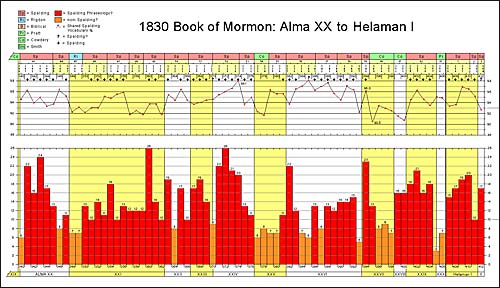
This chart of the Alma2 segment of the "Book of Solomon" has been reduced in size to fit easily into this web-page, but the full-sized original is also available for viewing here. To view either the scanned 1830 pages images or their text, along with other chart details, click here. Three different sets of data pertaining to the same section of the 1830 Book of Mormon text are illustrated in the graphic above. The most "subjective" of the data sets compiled for this illustration went into the construction of the bottom bar graph, where Spaldingish language was determined to apply to the phraseology contents of any 1830 Book of Mormon page containing ten or more "tabulated word-strings" (significant phraseology parallels) with the Oberlin Spalding manuscript. For this testing of the text, 515 shared word-strings were identified in the two sources (the Alma segment of the "Book of Solomon"and Oberlin manuscript). This initial set of shared word-strings was edited (to eliminate some short word-strings) and then expanded to a total of 621, with additions selected from the books of Mosiah and Ether. Generally speaking, every shared word-string of four or more contiguous words was included, along with a few shorter strings and a few "broken" strings, where not all of the words are contiguous. The occurrences of all these phraseology parallels were counted for each page in a color-coded html version of the 1830 Book of Mormon's Alma XX-Helaman I. Similar studies have also been conducted for Alma X-XIX and for the 1830 books of Mosiah and Ether, (the two latter texts supplying something like an introduction and an appendex to the Alma2 segment of the "Book of Solomon." Of course I was the one who decided which word-strings to tabulate and chart out, and I was the one who decided whether or not the results had any significence. Another investigator might pick a different set of phraseology parallels (perhaps containing more shared 3-word strings) to use in another such textual study. And a different investigator might set the boundary level for "Spaldingish" at a different value than the average (about ten occurrences in a single page), which I selected for my cut-off number. Thus, while I do not think my word-strings identification and computational mathematics can be much criticized, I'm forced to agree with Dr. Bush's 1982 conclusion, that such charting is still something of a subjective exercise. To compensate for that very problem, I added two additional graphs atop my page-by-page bar graph, to serve as correction indicators, in case my initial bar graph was greatly inaccurate for one reason or another. The middle line graph connects values ranging from about 90% to over 98%, for the amount of Spalding/Book of Mormon word overlap on pages 340 to 411 of the 1830 Book of Mormon. These percentages were taken from the formula derivatives located at the top of each page in the color-coded text selection previously mentioned. In the case of this middle line graph, the patterns of vocabulary overlap there shown correspond roughly with the patterns of highs and lows portrayed in the bar chart. This is to be expected, since vocabulary and phraseology are inter-connected literary phenomena, and pages containing a relatively high count of Spaldingish word-strings should naturally also contain a relatively high percentage of overlap with Spalding's fiction vocabulary. The final data set, at the very top of the chart, is a color-coded representation of a section of computer output showing the distribution of frequently used, non-contextual words in the Book of Mormon, which correspond most closely with "word-print" derived in the Oberlin Spalding manuscript. In addition to Spalding's "word-print," determinations of probable authorship by Sidney Rigdon, Oliver Cowdery, Parley P. Pratt and Joseph Smith, Jr. are also included. These authorship attributions (broken down by modern LDS edition chapter divisions) are derived from an unpublished update of the 2008 study published by Stanford University researchers Jockers, Criddle and Witten. To sum up: My original 1980 color-coded chart was derived from a combination of quantitative analysis and subjective determinations regarding the similarity of portions of the two texts. The original inspiration for that study came as a result of my recognizing thematic similarities between parts of the Book of Mormon and Solomon Spalding's extant writings. My recognition of those story-line similarities was reinforced by my discovery of shared phraseology in Spalding and the Nephite Record. That is, a common set of mutually used word-strings that were put together to convey the same narrative messages or ideas in the two supposedly unrelated texts. The perceived patterns of occurence for these thematic parallels and word-strings have been reinforced by my discovery of similar patterns in the frequency of shared vocabulary (word overlap) in the two sources. And, finally, my view of how all of this can be fit together, so as to describe the physical limits of the "Book of Solomon" is enhanced (rather than diminished) by recent discoveries in Solomon Spalding word-print analysis. With all of these signs pointing in the same direction, I am convinced that the LDS edition's Alma 43:1-63:17 and Helaman 1:1-3:12 represent a largely undigested Spalding contribution to the Book of Mormon -- with some additional Spalding narrative outliers located in Mosiah, Ether and a few other, shorter segments of the "Nephite Record." The more I have investigated this subjectmatter, the stronger my conviction has become. My final complex, detailed illustration, then, represents the compiled and sorted data standing behind the first chart I presented on this web-page. I have taken the trouble to provide this view behind the scenes, so as to reassure those readers who might otherwise suspect that I construct my illustrations out of thin air. That is most definitely not the case, and I hope that in the future these "fancy charts" will not be condemned as examples of some whimsical attempt on my part to achieve "impossible precision" in proving anything. I was long counciled and advised by leaders in the Reorganized Church of Jesus Christ of Latter Day Saints not to "waste my time" in looking into the complexities of the "Spaulding lie," since that authorship theory had been long ago "exploded" with the publication of the one and only fictional story written by Mr. Solomon Spalding. The pressure I felt upon me, to avoid further inquiry and reporting, was continual and a constant hindrance in my seeking out and obtaining research materials and scholarly assistance. I sincerely doubt that so much as ten percent of the useful achival material held by the LDS and RLDS (CoC) churches has yet been examined, for its possible use in helping to confirm or refute the multiple facets of the Spalding-Rigdon authorship explanation. Nearly thirty years have now passed, since I drafted the first of my "fancy charts" and began to take Mr. Holley's "Book of Solomon" assertions seriously. I can only hope that another thirty years need not be wasted, before others begin to take those claims just as seriously. (under construction) |
The battle stories... (preliminary draft is under construction) |
This web page and the linked episodes are still under construction.
Some of the links provided below are not yet fully functional.
|
Go to top of this page
Spalding Saga: 01 | 02 | 03 | 04 | 05 | 06 | 07 | 08 | 09 | 10 | 11 | 12 Spalding Studies "Research" | Spalding Research Project | Special Collections "Home" | Oliver's Bookshelf | Mormon Classics | Newspapers | History Vault Last Revised:Dec. 9, 2009 |
